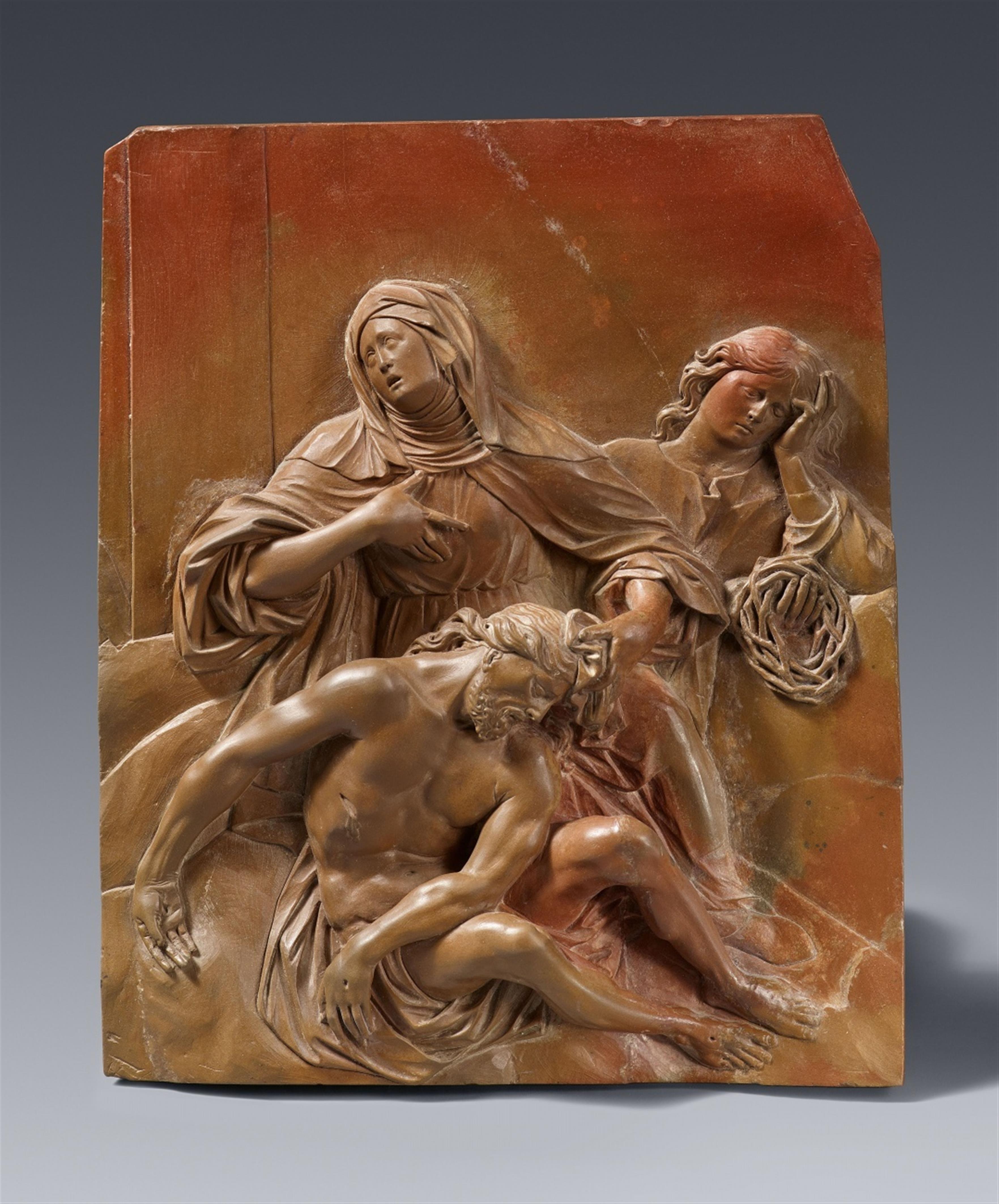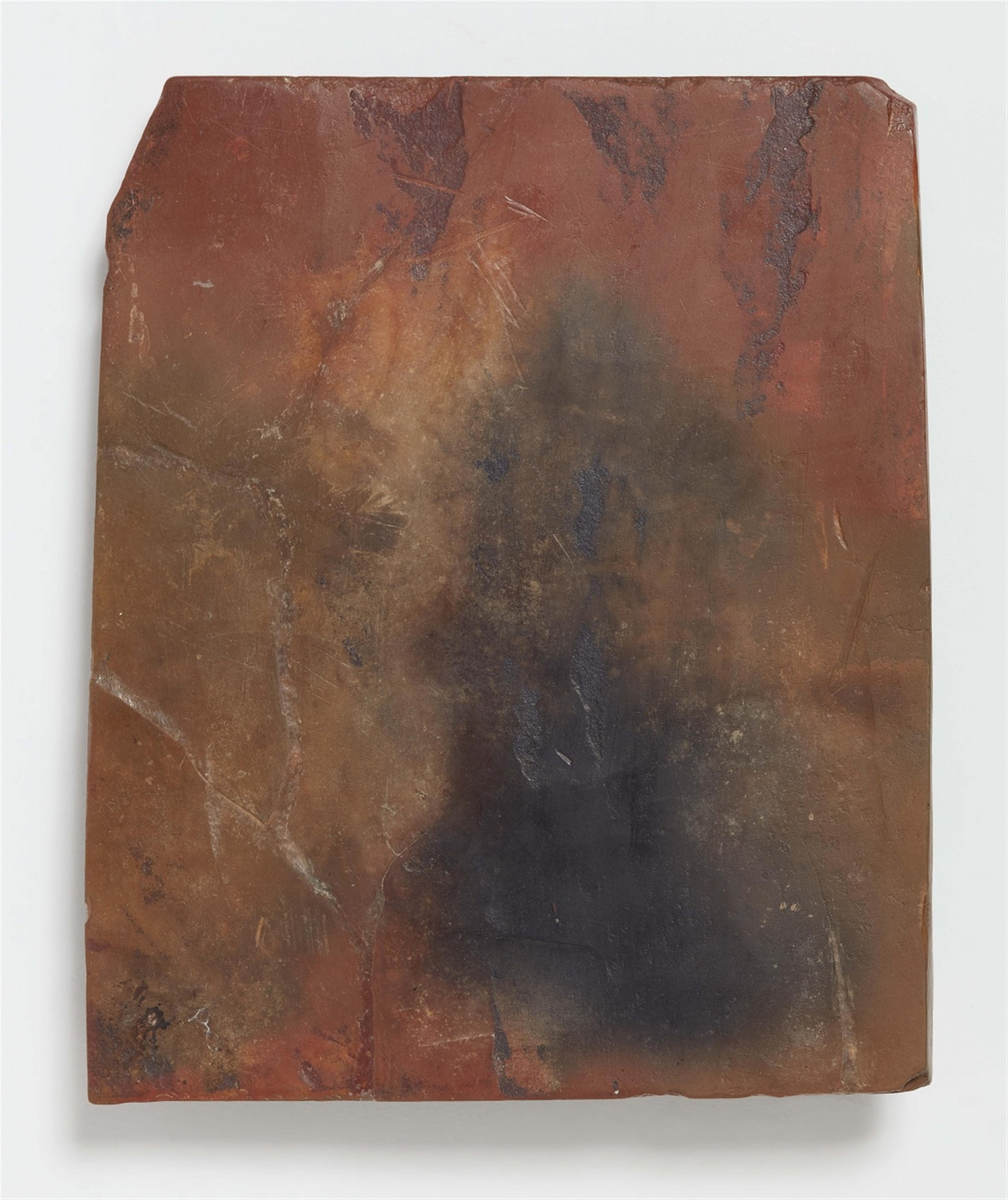An important Meissen Böttger stoneware relief with the Lamentation
Rectangular polished Böttger stoneware relief depicting the Virgin Mary, Christ and Saint John, with the vertical beam of the cross in the background. A retouched breakage to the right edge (possibly occurring during the firing process). H 18.3, W 15 cm.
Ca. 1710 – 11.
This Böttger stoneware relief is based on a motif produced by the Augsburg engraver Matthäus Küsel (1621 - 1689) after a painting by Johann Christoph Storer (1620 - 1671). Jutta Kappel found the engraving while researching a virtually unknown boxwood relief housed in the Green Vault in Dresden (inv. no. VII 27). Both the engraving and the boxwood relief show the same group of three figures, albeit with varying details. Another variation on the same theme by Storer can be seen on this hitherto unknown Böttger stoneware relief. In contrast to the two earlier objects, in this relief, Mary's plaintive expression is intensified by the almost free-standing placement of the hand on Her chest. The hand supporting the fallen saviour's head is also sculpted in the round, and the folds of the cloth billowing out between the head and the hand testify to the sculptor's skill. In contrast to the original, the figure of Saint John has been moved closer to the central group. The position of his upper body behind Mary is not clearly defined, and this appears to provide an explanation as to why the relief was not produced more frequently. A hand holding the crown of thorns is placed abruptly on the edge of the rock, and conceals the rest of his body. However, the sculpting of the right hand on which Christ's head rests, was carried out very finely.
Despite the possible firing damage and the smoke stains on the back of the piece, the surface of the relief was nevertheless finely polished. Astonishingly, even a minute detail such as the halo of Virgin, which may have been carved into the mass with a brush handle, survived the fire well enough to accurately reproduce the delicate rays of the copper engraving. The boxwood relief in the Green Vault, monogrammed ICL, was made by an exceptional wood carver thought to have been active in the Constance area or in the region around Lake Constance and is known only by this notname. The relief, which can be dated to shortly after 1665, was presumably known and accessible to the modeller of this stoneware plaque, as he attempted to incorporate similar alternations between low relief and fully sculpted elements in his interpretation. This is particularly noticeable in the head, torso, and legs of Christ, which protrude almost entirely from the plate. On the other hand, the modeller did not adopt one detail from the engraving and relief: At Christ's feet are three crucifixion nails, and Mary brings the fourth to Her chest. This motif is missing entirely in the Böttger stoneware piece.
Aside from portrait medallions, very few other reliefs were produced using Böttger stoneware. The Dresden Porcelain Collection houses a head of Saint Peter (inv. no. PE 2402) traditionally attributed to Balthasar Permoser, as well as a panel with Mary, the Christ Child, Saint Zacharias and the young Saint John (inv. no. PE 2403). There is also relief of Judith with the head of Holofernes, which is attributed to Paul Heermann on the basis of an identical ivory relief monogrammed with his initials PH in the collection of the State Museum Schwerin/Ludwigslust/Güstrow (inv. no. KH 1879). More than 100 versions of this relief are mentioned in the inventory of the Meissen manufactory in 1711. We know of no other example of this relief with the Lamentation of Christ, which can certainly also be dated to this period.
The first red porcelain was successfully produced by Johann Friedrich Böttger (1682 - 1719) in May 1706, about two years before he discovered the composition of the white mass. For this "jasper porcelain" he used clays rich in iron oxide from Plauen and a material that his successor, the arcanist Samuel Stöltzel (1685 - 1737), refers to as "English earth" (probably red bole). In 1710, the year the manufactory was founded, nine potters and 27 glass cutters worked there, processing the hard-fired red material. In 1712, of these, only 19 glass cutters were still working, meaning that white porcelain, which did not need this finishing, was now being produced more in contrast to the red material, which was now less in demand.
However, in 1710, the excitement over the discovery of the new material was unbridled. The list of "sample pieces" produced in Böttger stoneware includes "gantze ovens, camines, (...) Thür-posten, kleine Särge, Leichen-Steine, Antiche Urnen, Allerhand Tafeln zu Belegung der Fuß-Böden, Schmuck-Kästgen, Kleine Klocken-Spiehle, Hand-Granaten" and many others. They copied blanc de chine figures and created a series of busts of European emperors. In short, the possibilities of the material were feverishly explored. It is against this background that one must imagine the production of this Lamentation relief.
Provenance
South German Private collection.
Literature
Kappel, Eine Pietà von Buchsbaumholz des Monogrammisten ICL. Anmerkungen zu einem fast unbekannten Reliefbild des Grünen Gewölbes, in: Dresdener Kunstblätter 04/2003, p. 217 ff.
The relief of Judith with the head of Holofernes in Kappel (ed.), An-Sichten. Barocke Elfenbeinkunst im Dialog der Künste, Ausstellungskat. Dresden 2017, no. 39 f.
Cf. also Menzhausen, Das Älteste aus Meißen: Böttgersteinzeug und Böttgerporzellan, in: Meißen Frühzeit und Gegenwart. Johann Friedrich Böttger zu Ehren, Dresden 1982, p. 88 ff.




